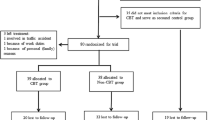Abstract
The aim of the present study was to investigate the 2-year outcome of a cognitive-behavioral training program for the management of depressive symptoms for patients with chronic low back pain (CLBP) and co-existing depressive symptoms compared with the standard rehabilitation. Therefore, a quasi-experimental 3 × 2 × 5 (treatment condition × gender × time) repeated measures design with five assessment points (pre-treatment, post-treatment, 6-, 12-, and 24-month follow-up) was employed among N = 153 patients with CLBP, aged 33–62 years. Patients were consecutively assigned to one of three treatment conditions: patients with no or mild depressive symptoms were treated with the standard rehabilitation (CG) and patients with moderate or severe depressive symptoms were either treated with the standard rehabilitation (CGdepr) or the standard rehabilitation plus cognitive-behavioral management of depressive symptoms (IGdepr). Patients in the IGdepr significantly improved in mental health up to the 6-month follow-up and in anxiety and depressive symptoms up to the 24-month follow-up. Only short- or mid-term improvements were found in the CGdepr. In conclusion, the new cognitive-behavioral training program augmented the long-term rehabilitation success in this highly strained subgroup of patients with CLBP and depressive symptoms.

Similar content being viewed by others
References
Linton SJ (2000) A review of psychological risk factors in back and neck pain. Spine 25:1148–1156
Pincus T, Burton AK, Vogel S, Field AP (2002) A systematic review of psychological factors as predictors of chronicity/disability in prospective cohorts of low back pain. Spine 27:E109–E120
Bair MJ, Wu J, Damush TM, Sutherland JM, Kroenke K (2008) Association of depression and anxiety alone and in combination with chronic musculoskeletal pain in primary care patients. Psychosom Med 70:890–897
Rush AJ, Polatin P, Gatchel RJ (2000) Depression and chronic low back pain: establishing priorities in treatment. Spine 25:2566–2571
Sullivan MJL, Adams H, Tripp D, Stanish WD (2008) Stage of chronicity and treatment response in patients with musculoskeletal injuries and concurrent symptoms of depression. Pain 135:151–159
van der Hulst M, Vollenbroek-Hutten MMR, Ijzerman MJ (2005) A systematic review of sociodemographic, physical, and psychological predictors of multidisciplinary rehabilitation or, back school treatment outcome in patients with chronic low back pain. Spine 30:813–825
Mohr B, Gräf T, Forster M, Krohn-Grimberghe B, Kurzeja R, Mantel F, Thomsen M, Hampel P (2008) Der Einfluss von Depressivität und Geschlecht auf den Rehabilitationserfolg bei chronischem Rückenschmerz: eine Pilotstudie [Influence of depressive symptoms and gender in chronic low back pain rehabilitation outcome: a pilot study]. Rehabilitation 47:284–298
Guzmán J, Esmail R, Karjalainen K, Malmivaara A, Irvin E, Bombardier C (2001) Multidisciplinary rehabilitation for chronic low back pain: systematic review. BMJ 322:1511–1516
Morley S, Ecclestone C, Williams A (1999) Systematic review and meta-analysis of randomized controlled trials of cognitive behavior therapy and behavior therapy for chronic pain in adults, excluding headache. Pain 80:1–13
Scascighini L, Toma V, Dober-Spielmann S, Sprott H (2008) Multidisciplinary treatment for chronic pain: a systematic review of interventions and outcomes. Rheumatology 47:670–678
Henschke N, Ostelo RWJG, van Tulder MW, Vlaeyen JWS, Morley S, Assendelft WJJ, Main CJ (2010) Behavioral treatment for chronic low-back pain. Cochrane Database Syst Rev (7):Art. No.: CD002014. doi:10.1002/14651858.CD002014.pub3
van Middelkoop M, Rubinstein SM, Kuijpers T, Verhagen AP, Ostelo R, Koes B, van Tulder MW (2010) A systematic review on the effectiveness of physical and rehabilitation interventions for chronic non-specific low back pain. Eur Spine J 20:19–39
Bingefors K, Isacson D (2004) Epidemiology, co-morbidity, and impact on health-related quality of life of self-reported headache and musculoskeletal pain: a gender perspective. Eur J Pain 8:435–450
Rollman GB, Lautenbacher S (2001) Sex differences in musculoskeletal pain. Clin J Pain 17:20–24
Unruh AM (1996) Gender variations in clinical pain experience. Pain 65:123–167
Jensen IB, Bergström G, Ljungquist T, Bodin L (2005) A 3-year follow-up of a multidisciplinary rehabilitation program for back and neck pain. Pain 115:273–283
McGeary DD, Mayer TG, Gatchel RJ, Anagnostis C, Proctor TJ (2003) Gender-related differences in treatment outcomes for patients with musculoskeletal disorders. Spine J 3:197–203
Hampel P, Graef T, Krohn-Grimberghe B, Tlach L (2009) Effects of gender and cognitive-behavioral management of depressive symptoms on rehabilitation outcome among inpatient orthopedic patients with chronic low back pain: a 1 year longitudinal study. Eur Spine J 18:1867–1880
van Tulder MW, Koes B, Malmvaara A (2006) Outcome of non-invasive treatment modalities on back pain: an evidence-based review. Eur Spine J 15:S64–S81
Hautzinger M, Bailer M (1993) Allgemeine Depressions-Skala (ADS). Die deutsche Version des CES-D. Manual [German version of the CES-D]. Beltz, Weinheim
Herrmann-Lingen C, Buss U, Snaith RP (2005) HADS-D Hospital Anxiety and Depression Scale-Deutsche Version [HADS-D Hospital Anxiety and Depression Scale-German version], 2nd edn. Huber, Bern
Bullinger M, Kirchberger I (1998) SF-36 Fragebogen zum Gesundheitszustand. SF-12 Kurzversion des SF-36 [SF-12. German short version of the SF-36]. Hogrefe, Göttingen
Cohen J (1977) Statistical power for the behavioral sciences. Academic Press, New York
Pfingsten M, Hildebrandt J, Leibing E, Franz C, Saur P (1997) Effectiveness of a multimodal treatment program for chronic low-back pain. Pain 73:77–85
Mangels M, Schwarz S, Worringen U, Holme M, Rief W (2009) Evaluation of a behavioral-medical inpatient rehabilitation treatment including booster sessions: a randomized controlled study. Clin J Pain 25:356–364
Linton SJ, Nordin EN (2006) A 5-year follow-up evaluation of the health and economic consequences of an early cognitive behavioral intervention for back pain: a randomized, controlled trial. Spine 31:853–888
Acknowledgments
The study was sponsored by the German Pension Insurance Company, Oldenburg-Bremen.
Author information
Authors and Affiliations
Corresponding author
Rights and permissions
About this article
Cite this article
Tlach, L., Hampel, P. Long-term effects of a cognitive-behavioral training program for the management of depressive symptoms among patients in orthopedic inpatient rehabilitation of chronic low back pain: a 2-year follow-up. Eur Spine J 20, 2143–2151 (2011). https://doi.org/10.1007/s00586-011-1810-x
Received:
Revised:
Accepted:
Published:
Issue Date:
DOI: https://doi.org/10.1007/s00586-011-1810-x




